Nuclear Tourism: When atomic tests were a tourist attraction in Las Vegas, 1950s

At night, the glow of the bombs lit up the sky, and mushroom clouds could be spotted rising over the horizon during the day.
In classical American fashion, fear was not the only reaction. Vegas started becoming a destination for a certain type of people — Nuclear Tourists.
Let’s roll back to understand why Nevada was selected for nuclear testing . The Yucca Flats of Nevada was located in the center of the American wasteland, making it the perfect place for nuclear testing. First off by being located in the middle of the desert, it created very few threats to surrounding homes.
Additionally, over 87% of the Nevada area is owned by the federal government. It had vast available lands, sunny weather, and good rail connections.
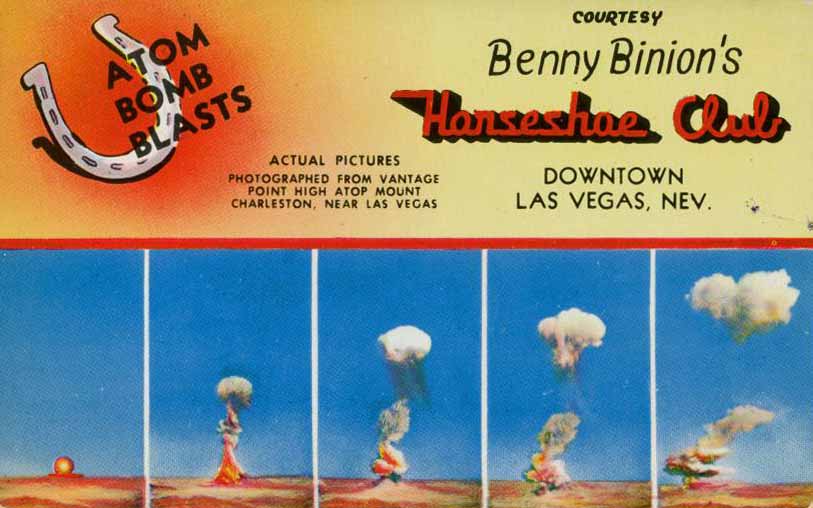
A Horseshoe Club advertisement touting its excellent views of nuclear tests.
The nuclear detonations provided a source of spectacles and entertainment for people who did live in this area. As a result, Vegas began to experience a new influx of people from across the country who would travel thousands of miles in order to catch a glimpse of this new show.
Soon after Las Vegas was transformed from the original city of 25,000 people to the world-renown spectacle of three million people.
Journalists everywhere began jumping on this new exciting event, and the topic of atomic tourism became the biggest headliner everywhere.
Even writers in the New York Times began referring to it as, “the non- ancient but nonetheless honorable pastime of atom-bomb watching.”

Witness the power of the Atomic Bomb. A mere $3 for a safe viewing distance.
Inherently speaking, Vegas was designed for showmanship. Visitors are encouraged to live in the moment and focus on what is in front of them, by masking the individual from all reminders of time and location.
Their motto: pay attention to what is in front of you. Therefore by taking advantage of this concept and its psychological effect, landowners and industry owners began turning these tests into spectacles of themselves.
The Vegas Chamber of Commerce promoted in advance the dates and times for these tests. Calendars and community announcements would be published months in advance for tourists to plan and enjoy the spectacle of the mushroom cloud.
Photos of these events began circulating across news sources everywhere and bomb-watching became such a rage that thrill-seeking tourists would make sure to get the closest spot possible to the ground-zero.
On the eve of detonations, many Las Vegas businesses held “Dawn Bomb Parties.” Beginning at midnight, guests would drink and sing until the flash of the bomb lit up the night sky.

Bombs over Fremont.
However, in addition to these parties, Vegas also capitalized on the nuclear tests by providing itself as a source of relief and nostalgia from the surrounding terror.
Gambling, games, and television were all sources of distraction that provided Vegas guests with an escape from the fear that was surrounding them.
Both Vegas itself and the Yucca Flats of the Nevada Testing Site were turned into tourist attractions of various sorts. The main spectacle of the site to date are the large craters currently scarring the desert surface.
The desert floor is sprinkled with craters of all shapes and sizes, ranging from nuclear warheads to smaller surface-level bombs.
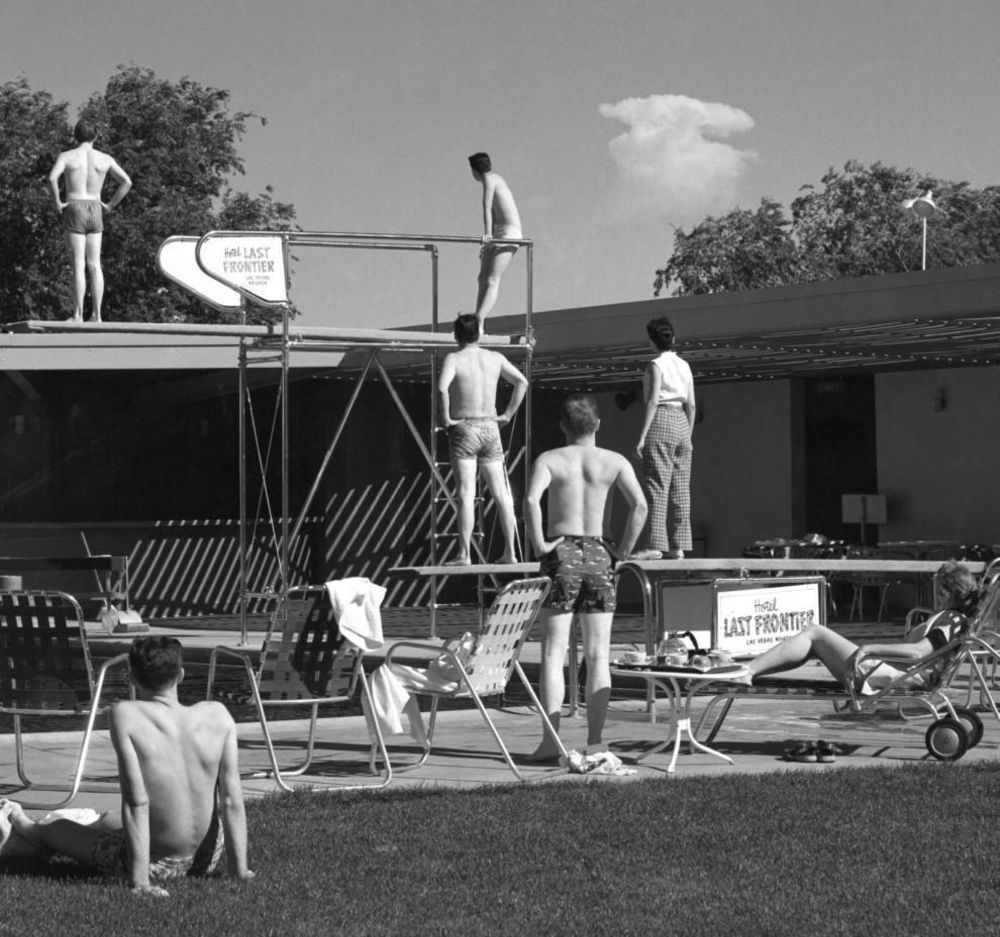
Early morning bathers at a hotel pool in Las Vegas stop to watch the mushroom cloud of an atomic detonation at a test site about 75 miles from the city. May 8, 1953.
One of the more popular craters is Bilby crater, which was created in 1963 by an underground test. Producing about 249 kilotons of explosive power, the blast created a hole that was 1,800 feet wide (550m) and 80 feet (24m) deep and also resulted in an aftershock that was felt all the way in Vegas itself.
Sedan crater is also popular due to its large size. Sitting at about 1280 feet (1280m) wide and 230 feet (70m) deep, a 104 kiloton blast right beneath the surface of the desert floor produced this crater.
The effects compared to that of a 4.75 earthquake moved about 12 million tons of Earth in its passing.
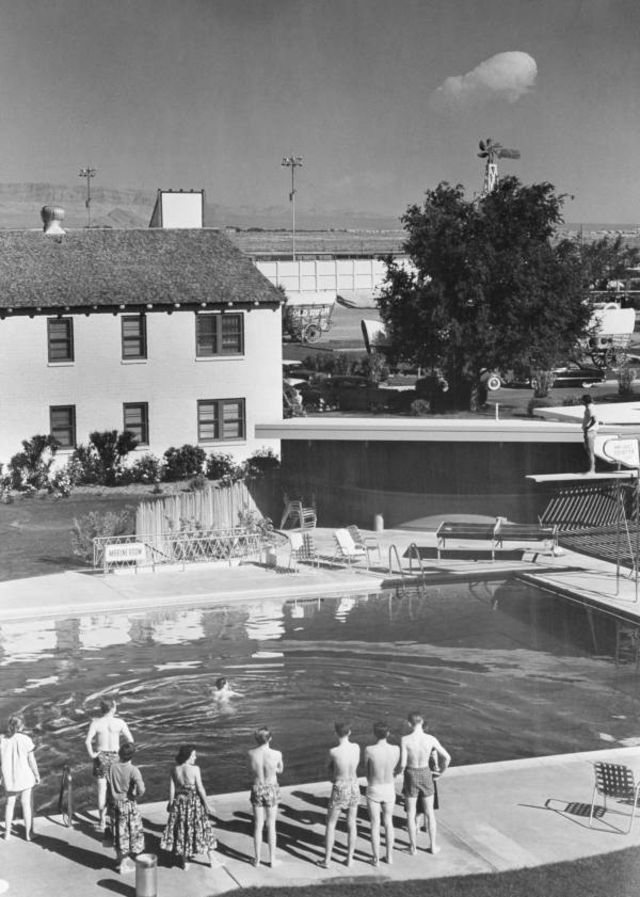
Guests at the Last Frontier hotel in Las Vegas watch the mushroom from a detonation about 75 miles away. May 8, 1953.
One journalist, writing for the Department of State Washington Bulletin, described witnessing the blast: “You put on the dark goggles, turn your head, and wait for the signal. Now — the bomb has been dropped. You wait the prescribed time, then turn your head and look.
A fantastically bright cloud is climbing upward like a huge umbrella…. You brace yourself against the shock wave that follows an atomic explosion.
A heat wave comes first, then the shock, strong enough to knock an unprepared man down. Then, after what seems like hours, the man-made sunburst fades away.”
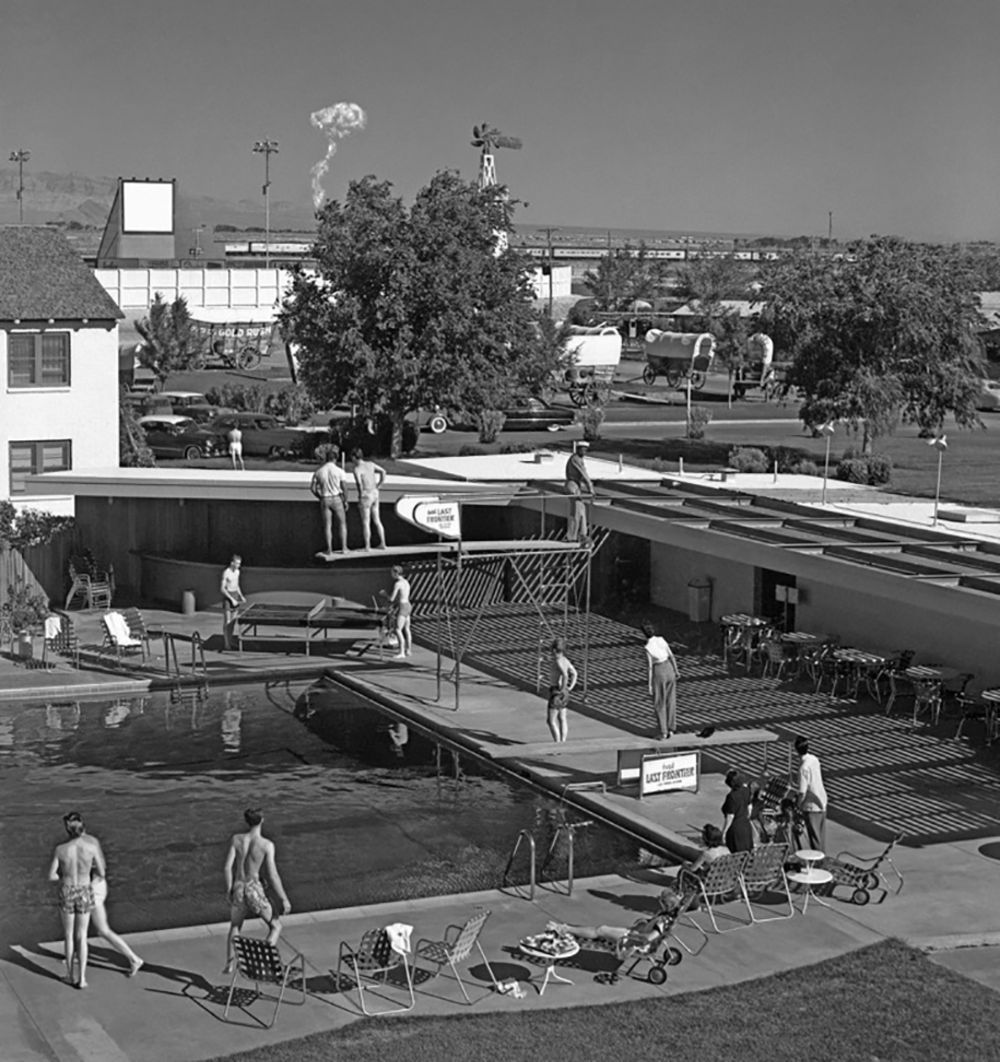
Watching poolside. Nuclear tests were a rather ordinary part of life in Las Vegas.
For twelve years, an average of one bomb every three weeks was detonated, at a total of 235 bombs. Flashes from the explosions were so powerful that they could reportedly be seen from as far away as Montana.
Scientists claimed that the radiation’s harmful effects would have dissipated and been harmless once the shock waves reached Las Vegas, and they scheduled tests to coincide with weather patterns that blew fallout away from the city.
However, as the tests continued, people in northeastern Nevada and southern Utah began complaining that their pets and livestock were suffering from beta particle burns and other ailments; by 1963 the Limited Test Ban was in effect, banning above-ground nuclear testing at the site.
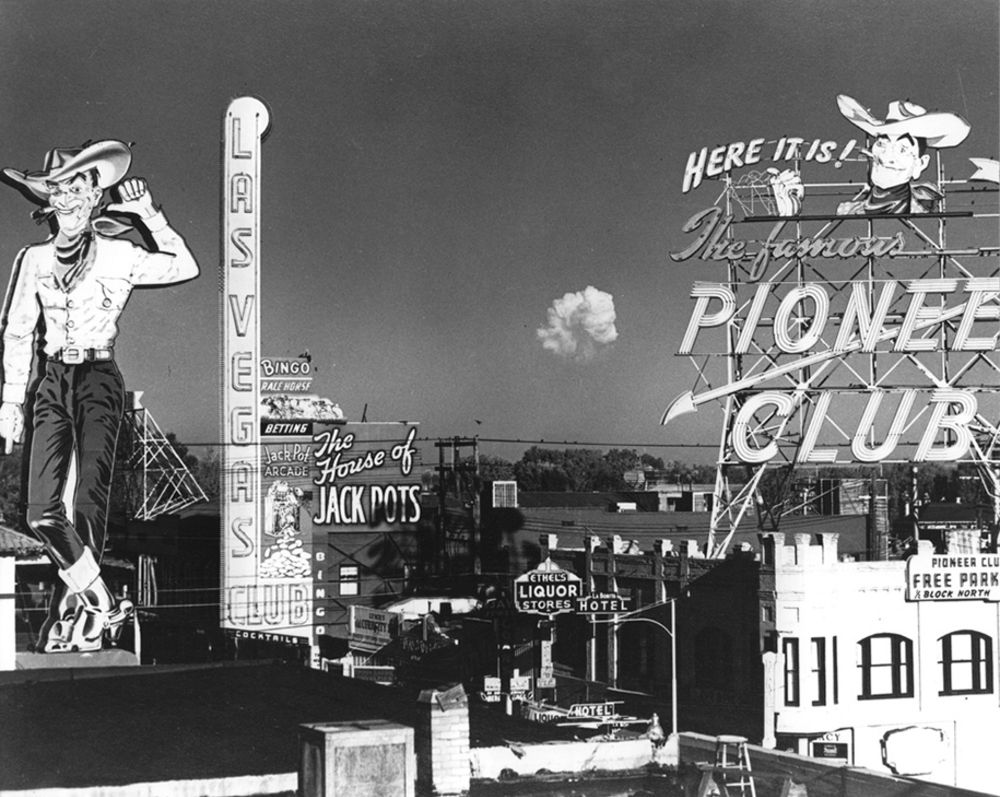
Hotels offered panoramic views of the distant desert skyline for the optimum experience.
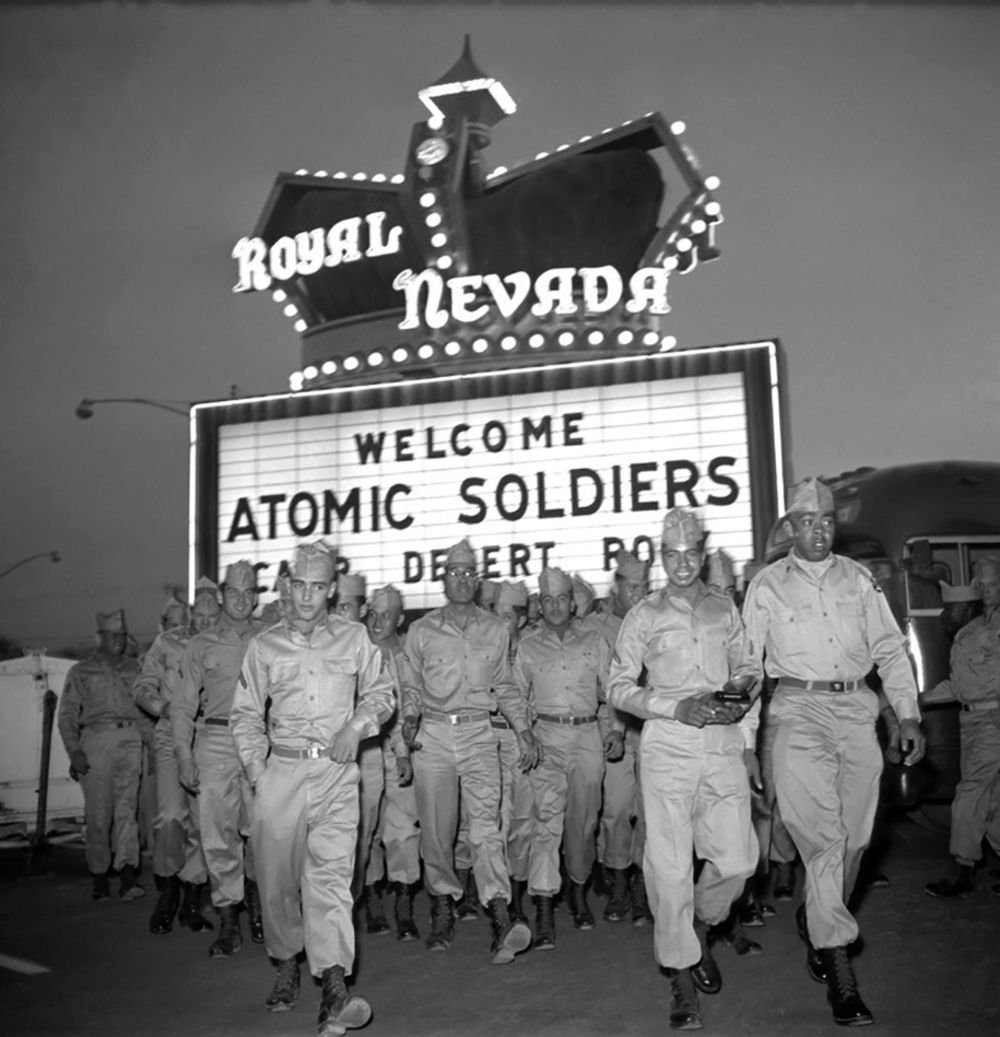
The Nevada Test Site wasn’t just a boom for travelers. The proving ground flooded the area with federal funds, and the site employed close to 100,000 men and women.
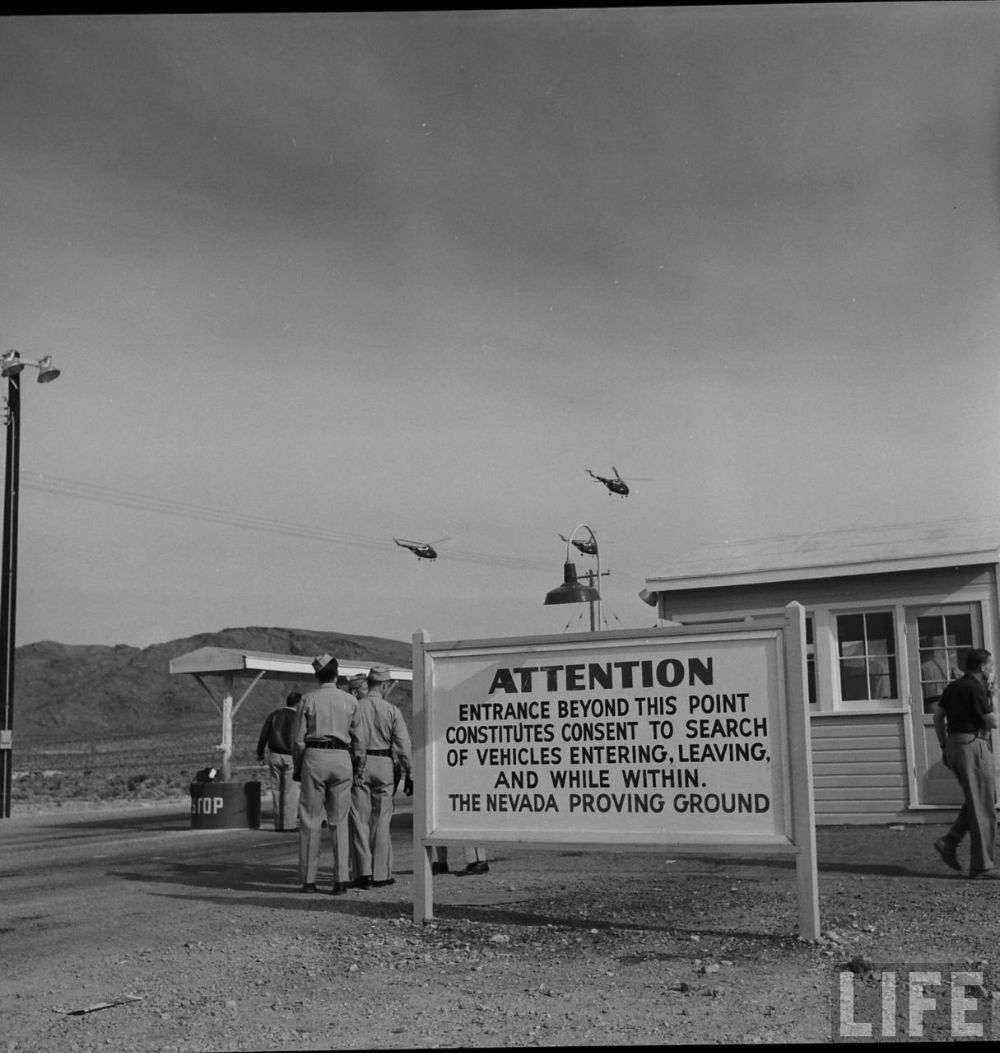
Nevada test site.
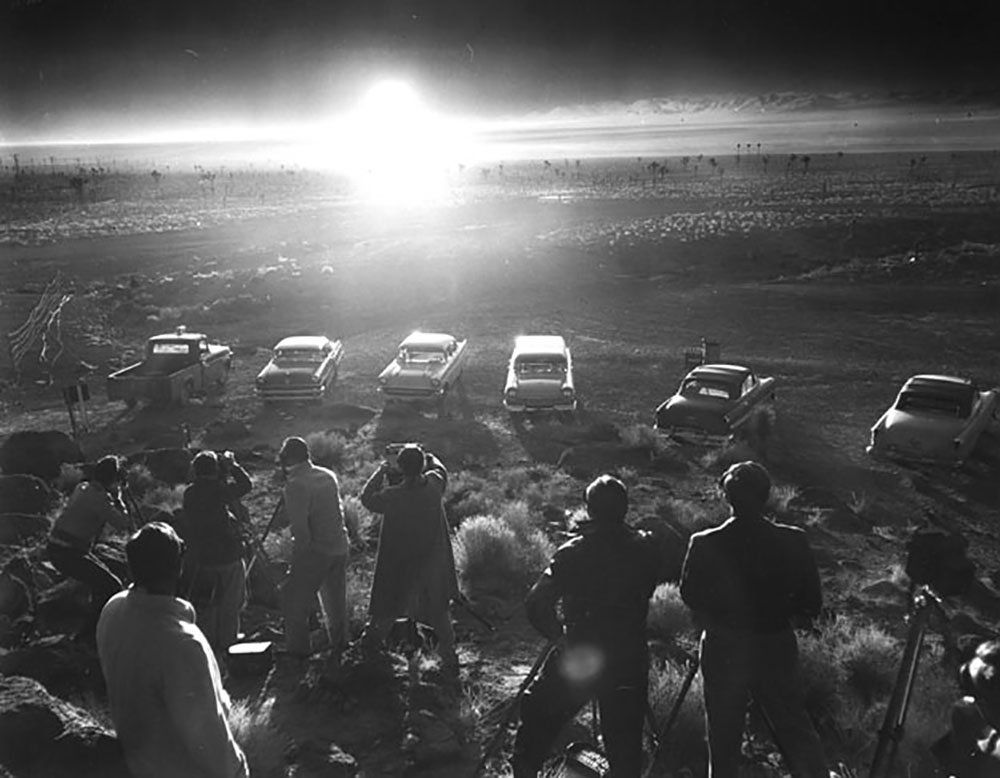
Reporters witness the nuclear test on Frenchman Flat, on June 24, 1957.
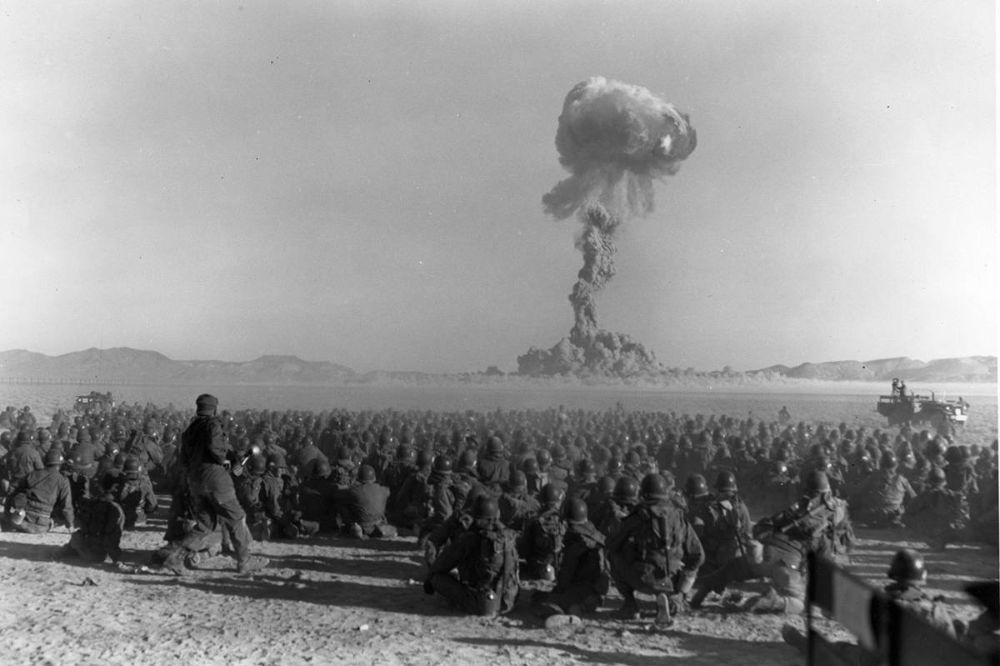
Operation Buster-Jangle – Dog test — with troops participating in exercise Desert Rock I, November 1, 1951. It was the first U.S. nuclear field exercise conducted on land; troops shown are a mere 6 miles from the blast.

Atomic tourists taking in the sites.
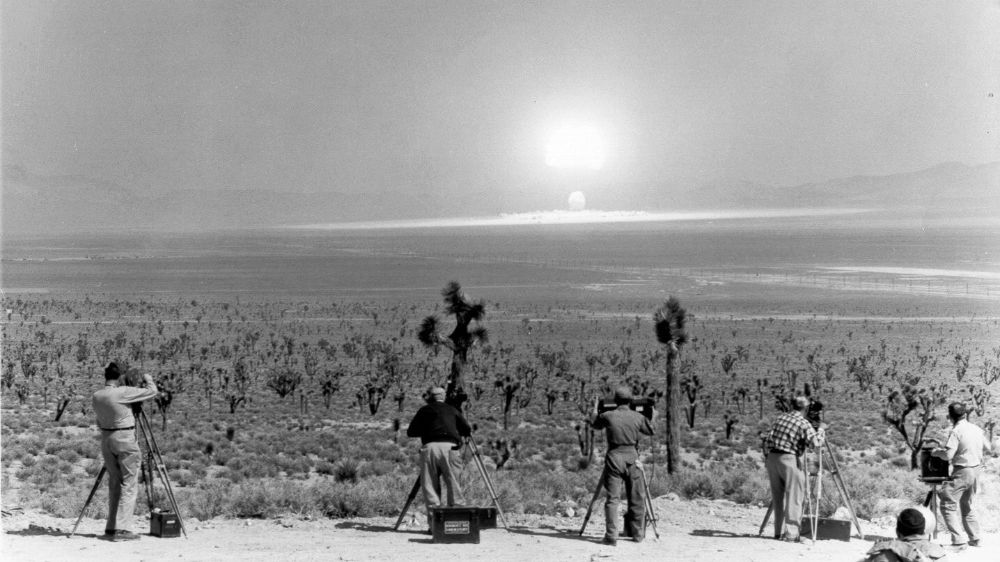
Camera men filming the atomic blast of Wasp Prime Test, during Operation Teapot. Nevada, February 18, 1955.
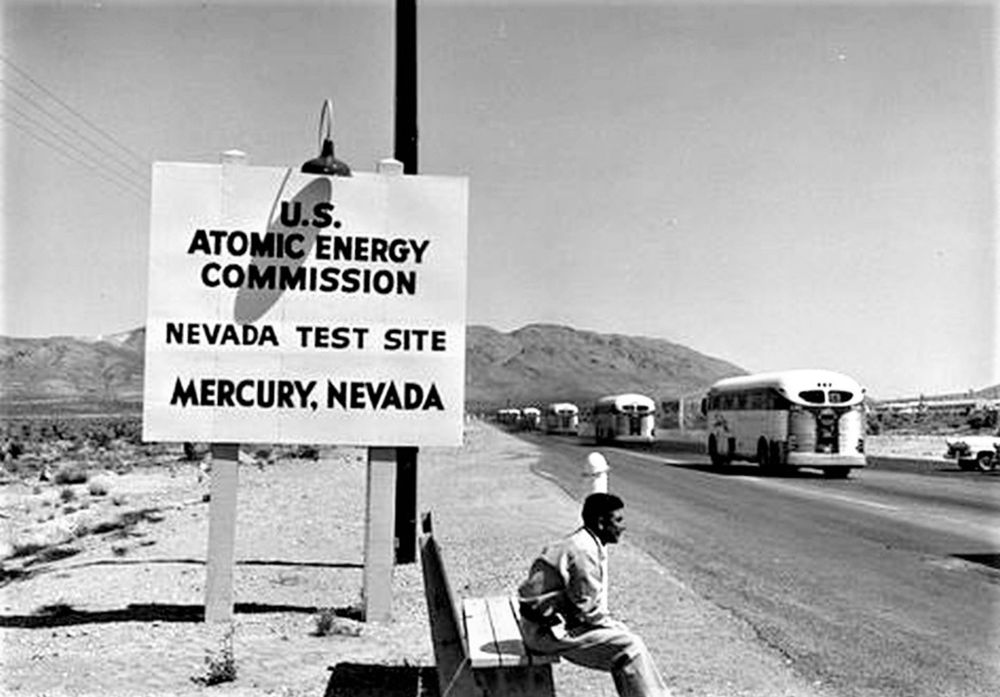
Man sitting near a Nevada Test Site sign, Nevada, United States, 1955 From 1951–1962, Mercury was a town in the Nevada atomic testing site where hundreds of test explosions were conducted.

Watching poolside.

Soldiers at the test site.

Fashion of the atomic age.

The first flash of light generated by an atomic bomb.

Birds-eye view of dozens of craters dotting the Yucca Flats.

A nuclear crater left behind.

Model posing in front of a nuclear cloud.

Miss Atomic Bomb of Sin City.

Photograph of Yucca Flat, covered with craters created by atomic bombs, in the Nevada Test Site.
(Photo credit: Wikimedia Commons / Las Vegas News Bureau / US Army Archives / Atomic Tourism in Las Vegas by Kiana Pancino).
Updated on: September 29, 2022
Any factual error or typo? Let us know.

How 1950s Las Vegas Sold Atomic Bomb Tests as Tourism
Between 1950 and 1960, the population of Las Vegas grew by 161%--partly due to the burgeoning casino industry. But another reason was a chance to glimpse actual nuclear tests in person. (01:30)
We've detected unusual activity from your computer network
To continue, please click the box below to let us know you're not a robot.
Why did this happen?
Please make sure your browser supports JavaScript and cookies and that you are not blocking them from loading. For more information you can review our Terms of Service and Cookie Policy .
For inquiries related to this message please contact our support team and provide the reference ID below.
8 Places That Showcase Atomic Age Archaeology for Tourists
Eight places tell the story of the nuclear era.
By some reckonings, the Cold War began in 1945 at Trinity Site, New Mexico, with the explosion of the first atomic bomb, and ended 41 years later at Chernobyl, where the meltdown of a nuclear reactor became a precipitating event of the Soviet Union's downfall. (Read more in National Geographic magazine: "The Nuclear Tourist: An unforeseen legacy of the Chernobyl meltdown." )
Today some of the era's historic sites are open to visitors—a reminder of a time when two great powers were continuously on alert to wage nuclear war. Here are some of the key locations:
1. A Chain Reaction Starts in Chicago
On Ellis Avenue at the University of Chicago, a bronze Henry Moore sculpture marks the site of Chicago Pile 1 . It was here in 1942, the early days of the Manhattan Project, that Enrico Fermi and his team ignited the first self-sustaining nuclear chain reaction. The following year, the reactor's graphite blocks were dismantled and reassembled for more experiments at a site in the Palos Forest Preserve, southwest of Chicago. In the mid-1950s it was decommissioned, and the remains, along with those of another reactor, were buried and marked with a stone monument —the world's first nuclear ruins.
2. A Bomb Is Born in New Mexico
From Chicago, the research moved to the cool mountain air of Los Alamos, New Mexico, where the first atomic bomb was made. ( Manhattan , the new TV series, has it wrong: This is not a desert.) A walking tour takes you by Fuller Lodge, the majestic log structure that served as a dining and meeting hall for the project, which occupied the site of a former boys' school. The guest cabin next to the lodge now houses the Los Alamos Historical Museum, and nearby are the homes of Bathtub Row, the comparatively luxurious residences where Robert Oppenheimer, Hans Bethe, and other luminaries lived. The old laboratory sites are still hidden within the pine forests of the fenced restricted area. But the Atomic Heritage Foundation is lobbying Congress to incorporate them into a National Historical Park. It would also include other Manhattan Project facilities like those in Hanford, Washington, and Oak Ridge, Tennessee.

Tourists at the Trinity Site in New Mexico, where the first atomic bomb was exploded in a test, examine a "Fat Man" bomb casing like the one that detonated over Nagasaki, Japan, on August 9, 1945, three days after the bombing of Hiroshima.
3. The Atomic Era Triggered at Trinity Site
FREE BONUS ISSUE
About 200 miles south of Los Alamos, in an area called Jornada del Muerto, or "journey of the dead," is Trinity Site. This really is a desert, and it was here on July 16, 1945, that the first atomic bomb—the Gadget—was exploded. Once a year, on the first Saturday in April, the site is open to tourists . The steel tower supporting the bomb was vaporized in the blast, and the crater was later filled and marked by an obelisk . The heat of the explosion fused sand and other debris into green glassy rocks called Trinitite. You're not allowed to take whatever pieces remain, though they often show up for sale on eBay.
4. Cities in Japan Recall Nuclear Devastation
The bombs had been meant for Hitler, but with the defeat of Germany the target became Japan. The two cities that were bombed, Hiroshima and Nagasaki, have built parks and monuments, near ground zero, in remembrance of the horror. The most striking site at the Hiroshima Peace Memorial Park is the wreckage of the Industrial Promotion Hall, now called the A-Bomb Dome. At the Nagasaki Peace Park , a masonry wall stands as a reminder of the original Urakami Cathedral, where parishioners were worshipping when the bomb fell.

A nuclear bomb detonates underwater in a 1946 test at Bikini Atoll that was intended to investigate the impact of an explosion on warships.
5. Bikini Atoll Becomes a Test Site
You May Also Like

This pill could protect us from radiation after a nuclear meltdown

The true history of Einstein's role in developing the atomic bomb

Who is Oppenheimer? The controversial man behind the atomic bomb
Less than a year after Japan's surrender came the first nuclear tests at Bikini Atoll in the remote Marshall Islands—remote, except to the inhabitants, who were relocated to nearby islands as a fleet of surplus ships, some captured from Japan and Germany, arrived. For the next few years the vessels served as targets for atomic bombs. The last and largest, in 1954, was a 15-megaton thermonuclear device —far more powerful than the scientists had reckoned—that spread radioactive fallout some Marshall Islanders mistook for snow. In the late 1970s a mammoth attempt to clean up and resettle the atoll ended in failure. Today it is a destination for divers , who can explore the sunken wreckage and lament the Bikinians' fate.
6. Nevada Desert Becomes a Testing Ground
From 1951 until the Limited Test Ban Treaty of 1963, more than a hundred nuclear weapons were detonated in the desert air of the Nevada Test Site. Afterward underground blasts continued there for 30 more years. Today the Department of Energy schedules monthly tours , which depart from the Atomic Testing Museum in Las Vegas and visit sites including the Sedan Crater (1,280 feet in diameter and 320 feet deep), part of the Plowshare Program to see if nuclear explosions could be used for mining and for excavating canals, roadcuts, and quarries. Another stop is Survival Town, site of the remains of buildings erected and populated with mannequins—nuclear crash-test dummies—and then rocked with atomic blasts.

A display at the Atomic Testing Museum in Las Vegas highlights some of the kitsch that grew out of the nation's postwar fascination with atomic energy.
7. Missile Silos Stay on Alert in Arizona
Throughout the Cold War, intercontinental ballistic missiles sat in their silos as crew members waited around the clock for orders to launch an attack on the Soviet Union. The legendary Titan II was capable of delivering a nine-megaton warhead at a speed of 15,000 miles an hour to targets across the ocean. Today at the Titan Missile Museum near Tucson, visitors can descend into a decommissioned silo and even arrange to spend the night. "What was it like for Titan II crew members to sleep underground only a few feet away from the largest missile ever made by the United States? Now you can find out!"
8. Bunkers Await U.S. Leaders in Virginia, West Virginia
Had there been a nuclear war with the Soviet Union, the president of the United States and other officials might have waited out the fallout in a vast bunker inside Mount Weather , Virginia. Congress, meanwhile, would have relocated to another underground facility at Greenbrier resort in the mountains of West Virginia, where chambers had been excavated for the House and Senate. Mount Weather , still in operation, is closed to the public, but the Greenbrier resort offers tours of the former retreat . After emerging from the cavernous hideout, guests of the hotel can enjoy a game of golf and then head for the casino, perhaps to contemplate the deadly gamble that was the nuclear arms race.
Follow George Johnson on Twitter and the Web .
Related Topics
- NUCLEAR ENERGY
- NUCLEAR WEAPONS
- ARCHAEOLOGY

‘A ball of blinding light’: Atomic bomb survivors share their stories

Oppenheimer: The secrets he protected and the suspicions that followed him

How Chien-Shiung Wu changed the laws of physics

U.S. nuclear testing's devastating legacy lingers, 30 years after moratorium

Just one pregnancy can add months to your biological age
- History & Culture
- Environment
- Paid Content
History & Culture
- History Magazine
- Terms of Use
- Privacy Policy
- Your US State Privacy Rights
- Children's Online Privacy Policy
- Interest-Based Ads
- About Nielsen Measurement
- Do Not Sell or Share My Personal Information
- Nat Geo Home
- Attend a Live Event
- Book a Trip
- Inspire Your Kids
- Shop Nat Geo
- Visit the D.C. Museum
- Learn About Our Impact
- Support Our Mission
- Advertise With Us
- Customer Service
- Renew Subscription
- Manage Your Subscription
- Work at Nat Geo
- Sign Up for Our Newsletters
- Contribute to Protect the Planet
Copyright © 1996-2015 National Geographic Society Copyright © 2015-2024 National Geographic Partners, LLC. All rights reserved

Atomic Testing Draws Tourists to Las Vegas
- Sally McCloskey, a ballerina and dancer from the Sands hotel, performed an interpretive dance on top of Mount Charleston called the 'Angel's Dance,' with an atomic mushroom cloud in the background on April 6, 1953. Las Vegas News Bureau photographer Don English thought up this publicity stunt, which proved to be a great success. In addition to the local 'Review-Journal', several other publications across the nation published this photo including 'Parade', a widely-circulated Sunday newspaper magazine. The 'Parade's' caption stated, 'Her task: to interpret the greatest drama of our time in dance rhythms. For high over her sinuous, leaping form rose a symbol no eye could miss: the pale, rising cloud of an atomic bomb just exploded 40 miles away.'
- The atomic mushroom cloud from The Priscilla Test, part of Operation Plumbbob, raised over Fremont Street on June 24, 1957. Las Vegas News Bureau photographer Don English accidentally captured this iconic image when he slept in and had to rush downtown to capture the blast on top of the drugstore. English recalls that he looked up, 'and by gosh all of a sudden there was the mushroom cloud right between Vegas Vic and the Pioneer Club, absolute perfectly in the center.' This famous image was published around the world and won 'LIFE' magazine's 'picture of the week.'
- Photographers captured an atomic blast at News Nob, the designated site for reporters to record images of the atmospheric tests, northwest of Las Vegas, Nevada, on June 24, 1957. In reaction to people’s interest, the Las Vegas Chamber of Commerce promoted the dates and times for these tests. Calendars and community announcements would be published months in advance for tourists to plan and enjoy the spectacle of the mushroom cloud, and the Las Vegas News Bureau would capture the blasts from various perspectives and these images were published around the world.
- On May 24th, 1957, the Las Vegas News Bureau captured the famous 'Miss Atomic Bomb' photo to coincide with Operation Plumbbob at the Nevada Test Site. News Bureau photographer, Don English, took the famous photo of the showgirl from the Sands’ Copa Room, thought to be Lee Merlin. The publicity photo is the most published photo in the Las Vegas News Bureau collection and has appeared and continues to appear in hundreds of publications worldwide.
- Photographers gathered outside of the Nevada Test Site at News Nob (which was only ten miles from ground zero), to shoot the atomic blast from the ESS Test, part of Operation Teapot, which was sponsored by the Los Alamos National Laboratory on March 23, 1955.
- Zsa Zsa Gabor and Spaulding Bisbee, The Civilian Defense Director of Maine, were at a meeting of the Ancient and Honorable Society of the Atom Bomb Watchers at the Flamingo, circa 1953.
- Actress Marie Wilson posed poolside at the Flamingo with a Geiger counter to promote atomic tourism in Las Vegas on February 10, 1955. There were two atmospheric tests in February 1955, named Wasp and Moth, which were part of Operation Teapot.
- Employees outside of the Civil Defense Administration in Las Vegas inspected mannequins from J.C. Penney which were sent to Yucca Flat on April 4, 1958. The mannequins were positioned around a million-dollar village, which was built to test the effects of an atomic blast on everything from food to clothing to homes made from different materials.
- Actor and comedian Danny Thomas posed outside of the Nevada Test Site on May 20, 1957, for a staged photo that would be placed in the Sands casino's time capsule to preserve the memory of nuclear testing outside of Las Vegas.
- NATO military observers watched Boltzmann, an above ground atomic test, which was part of Operation Plumbbob at the Nevada Test Site outside of Las Vegas on May 28, 1957.
- Eugene Gaynes, an atomic radiation victim, was examined outside of the United States Atomic Energy Commission's office in Las Vegas, circa 1954.
- Atomic soldiers arrived at the Royal Nevada on April 18, 1955. The soldiers were in Las Vegas for Operation Teapot, which was part of the atmospheric tests at the Nevada Test Site, northwest of Las Vegas.
- A mushroom cloud from the Hood Test, which was part of Operation Plumbbob at the Nevada Test Site on July 5, 1957. The test, sponsored by Lawrence Livermore National Laboratories, was the largest test ever conducted at the site with a yield of 74 kilotons.
- President John F. Kennedy toured the Nevada Test Site northwest of Las Vegas on December 8, 1962. While there, President Kennedy took an hour-long helicopter flight over the test site to see the damage an atomic blast could create. He also visited Area 25, which had been set aside for atomic research that did not involve weapons testing.
- Guests at the Last Frontier pool watched as a mushroom cloud rose from the Simon Test, part of the Operation Upshot-Knothole, at the Nevada Test Site outside of Las Vegas on April 25, 1953. The Las Vegas Chamber of Commerce issued a calendar for tourists, listing the scheduled times of the bomb detonations and the best places to view them.
- American opera singer Marquerite Piazza posed as 'Miss Radiation' with servicemen at the Sands' pool on March 29, 1955, to promote atomic tourism in Las Vegas.
- An atomic blast over Fremont Street, circa 1955. Las Vegas utilized its close proximity to the atomic testing grounds to promote itself as, 'Atomic City' a place where people could go and view atomic blasts. According to PBS An American Experience, 'On the eve of detonations, many Las Vegas businesses held 'Dawn Bomb Parties.' Beginning at midnight, guests would drink and sing until the flash of the bomb lit up the night sky.'
- An atomic mushroom cloud rose over the El Rancho Vegas on April 18, 1953. The blast, named Badger, was part of the Operation Upshot-Knothole, at the Nevada Test Site outside of Las Vegas. It was the sixth test in the series of atmospheric nuclear weapons testing.
- Priscilla, an atomic blast that was part of Operation Plumbbob, rose above Fremont Street on June 24, 1957. The test was performed at the Nevada Test Site 65 miles northwest of Las Vegas.
- According to the Smithsonian Channel, 'During the 1950s, the detonation of the Nevada Test Site gave Las Vegas a new way to make money, atomic tourism.' Proof of this mushrooming tourist industry can be seen here as tourists view an atomic blast from Fremont Street, circa 1955.
Looking for higher-quality images? Fill out a formal image request .
- Privacy Policy & Terms of Use
- VisitLasVegas.com
- VisitLaughlin.com
- VisitMesquite.com
- VisitBoulderCity.com
- VegasMeansBusiness.com

Back to top

Atomic Bomb Dome

- # Recommendation
- # History/ Culture
- # World Heritages

Basic information on the A-bomb Dome
In December 1996, it was registered as a World Cultural Heritage Site as a building that conveys the devastation of nuclear weapons at the 20th UNESCO World Heritage Committee Merida Conference.
Specified area: The area where the Atomic Bomb Dome is located/approx. 0.39 hectares
The Atomic Bomb Dome was built in 1915 as a facility to exhibit and sell products from Hiroshima prefecture, and also held Hiroshima prefectural art exhibitions and exhibitions. At the beginning of its establishment, it was called “Hiroshima Prefectural Products Display Hall,” but later it was renamed “Hiroshima Prefectural Product Display Center” and “Hiroshima Prefectural Industrial Promotion Hall” in Showa 8 (1933).

The designer was Czech architect Jan Letzl, and the structure was partially brickwork using steel, and the exterior was made of stone and mortar. The whole building was composed with a three-story staircase, another five-story staircase in the center , and an oval dome of copper plate (about 11 meters long axis, 8 meters short axis, 4 meters high) placed on it. At that time, most of the city center of Hiroshima was a wooden two-story building, and these bold European-style buildings were very rare, and together with the modern beauty that shines on the surface of the river, it was counted as one of the famous places in Hiroshima. I did it.

Showa 20 (1945) august 6, 8:15 a.m. The first atomic bomb in human history exploded at an altitude of about 160 meters southeast of the Hiroshima Prefectural Industrial Promotion Hall and about 600 meters. The pressure of the blast was 35 tons per square meter and the wind speed was 440 meters, and the building was wrecked by the blast and heat rays, and burned down by blowing fire from the ceiling. Since the blast worked almost vertically, the central part of the main building miraculously escaped collapse, but everyone who was in the building died instantly. After the war, the remnants of the former Industrial Promotion Hall came to be called the Atomic Bomb Dome by citizens due to the shape of the top canal and steel frame.

It was transferred from Hiroshima prefecture to Hiroshima city in Showa 28 (1953), and in Showa 41 (1966) July, the Hiroshima City Council resolved to preserve the Atomic Bomb Dome, and then weathering progressed, and three times through well-intentioned donations at home and abroad Large-scale preservation work was carried out. In addition, in search of registration on the World Heritage List, it was designated as a national historic site in June 1995 as a result of the city, the city council, and a wide range of civic movements, and applied for registration by UNESCO by the Agency for Cultural Affairs. It was registered as a World Cultural Heritage Site in December 1996. Today, the figure that left the tragic situation at the time of the atomic bombing is a symbol of No More Hiroshima, and it has become a symbol that appeals to the world the importance of the abolition of nuclear weapons and permanent peace over the ages.

*You cannot enter the Atomic Bomb Dome. It is not a facility where you can enter, so it will be a tour from the outside. ※There is no private parking lot, so please use a nearby parking lot.
Hiroshima Peace Tourism (Hiroshima Peace Tourism)
Hiroshima City has opened a website “Hiroshima Peace Tourism (Hiroshima Peace Tourism)”. Many visitors to Hiroshima introduce themed routes that can be used as a reference when visiting peace-related facilities. Also, on this website, AR etc. that allow you to see the inside of the Atomic Bomb Dome in 360° is posted. Why don't you go around the route while looking at the dedicated site with your smartphone in one hand?


RELATED LINKS Related links
- Peace Memorial Park
- Hiroshima Peace Memorial Museum
- Hiroshima National Peace Memorial Hall for the Atomic Bomb Victims
Location and access information
〒 730-0051 1-1-10 Otemachi, Naka-ku, Hiroshima-shi, Hiroshima
Related articles.

“EDION PEACE WING HIROSHIMA” A new soccer stadium in downtown has opened!

Let's go on a pilgrimage to real-life “Slam Dank” locations in Hiroshima!

[G7 Hiroshima Summit] Special Feature on Hiroshima's Traditional Culture Used the Partners Program

[HIT Editorial Department] Attention is also being paid at the G7 Hiroshima Summit! Hiroshima Food, Local Sake, and Traditional Culture
Share this article
Travel bookmarks.
All spots / experiences
This website stores cookies on your computer. nThis cookie is used by this site and other media to improve the website experience and to provide more personalized services. n For more information about our cookies, please see our Privacy Policy . This site does not track the personal information of visitors.
What is a Godzilla anyway? The 70-year-old monster behind the movies
Godzilla began life as a symbol of the horrific destruction caused by the atomic bombs dropped on Japan in 1945.
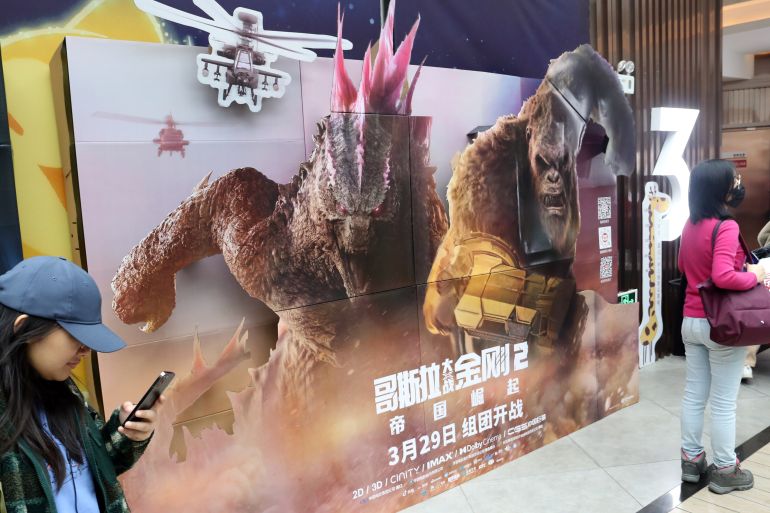
It’s Godzilla season again with last weekend’s worldwide theatrical release of Godzilla x Kong: The New Empire. This is the second time Godzilla and King Kong have made a film appearance together in recent times with 2021’s Godzilla vs Kong being the first instalment. Both films were directed by Adam Wingard.
Godzilla x Kong made back its budget of $135m in the first weekend when it took in $195m at cinemas, according to figures from Box Office Mojo. In total, it has sold $209m in tickets so far and has scored a very respectable 92 percent Rotten Tomatoes audience rating.
Keep reading
‘accepted in both [worlds]’: indonesia’s chinese muslims prepare for eid, photos: mexico, us, canada mesmerised by rare total solar eclipse, saving sarah: the last jewish embroidery shop in india’s kochi, ‘humour is powerful’: cartoons take on uganda’s repressive government.
The origins of Godzilla go back 70 years to the first 1954 film release in Tokyo, Japan – Gojira, directed by Ishiro Honda. According to Godzilla film lore, there are anywhere from 11 to 33 versions of Godzilla that have been designed across 38 live-action films. Thirty-three have been released in Japan and five in the United States.
Let’s explore this creature that’s terrified audiences for nearly three-quarters of a century.
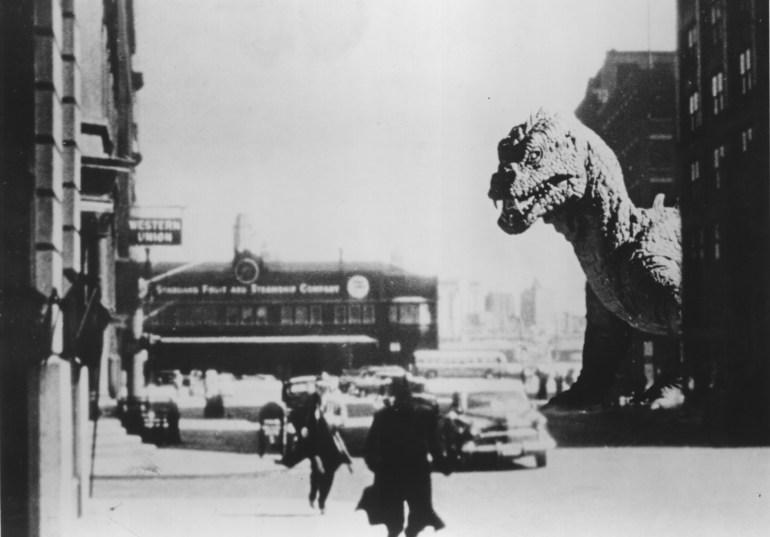
What even is a Godzilla?
Godzilla was inspired by a 1953 film, The Beast from 20,000 Fathoms, directed by Eugene Lourie, in which a giant monster is awakened by an atomic bomb detonation. The dinosaur-like monster has some similarities to Honda’s 1954 Godzilla film.
What many might not know is that Godzilla was seen as symbolic of the atomic bombs that the US dropped on Nagasaki and Hiroshima in August 1945.
“As long as nuclear weapons or nuclear power exists, Godzilla will never not be relevant,” Kazu Watanabe, the then-head of film at the Japan Society, a cultural centre in New York, said in an interview with NBC News in 2020. “Godzilla reminds us that we have the terrible power to create our own monsters and contribute to our own destruction.”
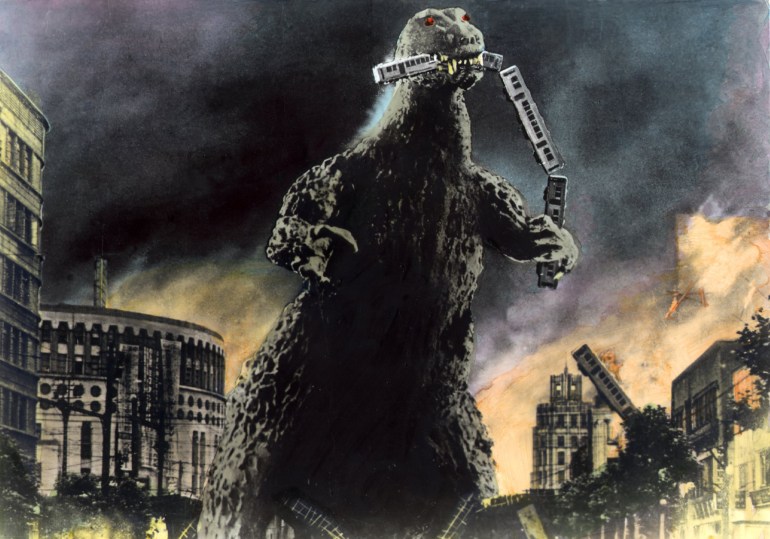
According to fan lore, Godzilla is a reptilian “kaiju”, or “large monster”, which has the ability to issue an atomic breath with the destructive capability of a nuclear blast. Godzilla is supposed to be 50 metres (165ft) tall and weigh 20,000 tonnes.
Originally created by Toho Studios in Japan in 1954, the name of the first Godzilla (Gojira) was devised from a combination of two Japanese words: “gorira”, which means gorilla, and “kujira”, which means whale.
“There was a big – I mean huge – fellow working in Toho’s publicity department, and other employees would say, ‘That guy’s as big as a gorilla.’ ‘No, he’s almost as big as a kujira,'” according to Steve Ryfle, author of the book Japan’s Favorite Mon-star: The Unauthorized Biography of “The Big G”, which exhaustively details the origin story of Godzilla.
Some attribute producer Tomoyuki Tanaka as the person who popularised the name Gojira because he was the creator of the Godzilla franchise.
Godzilla’s famous roar was originally created by composer Akira Ifukube, his assistant Sei Ikeno and sound technician Ichiro Minawa in 1954. It has been reinterpreted by various sound designers over the decades since.
The original Godzilla costume was worn by actor Haruo Nakajima from 1954 to 1972 over the course of 12 films. Nakajima started out acting in samurai films for Toho Studios and starred in Kurosawa Akira’s 1954 classic, Seven Samurai. But it was the Japanese war film Eagle of the Pacific, which also came out in 1954, that caused Honda to take notice of the bravery of Nakajima, who had to perform his own stunt, jumping out of an aeroplane on fire.
In a 2017 interview with Great Big Story, a London-based film company that produces mini-documentaries, Nakajima stated: “Mr Honda saw this scene and thought, ‘This guy is full of energy.’ They came to see me as someone who had guts, and I think that’s why they wanted me for the role of Godzilla.”
The original Godzilla suit weighed nearly 100kg (220lb). Ready-mixed concrete was used because rubber wasn’t readily available at the time. Later, Godzilla suits would use heavy urethane and bamboo, chicken wire, cushions and latex.
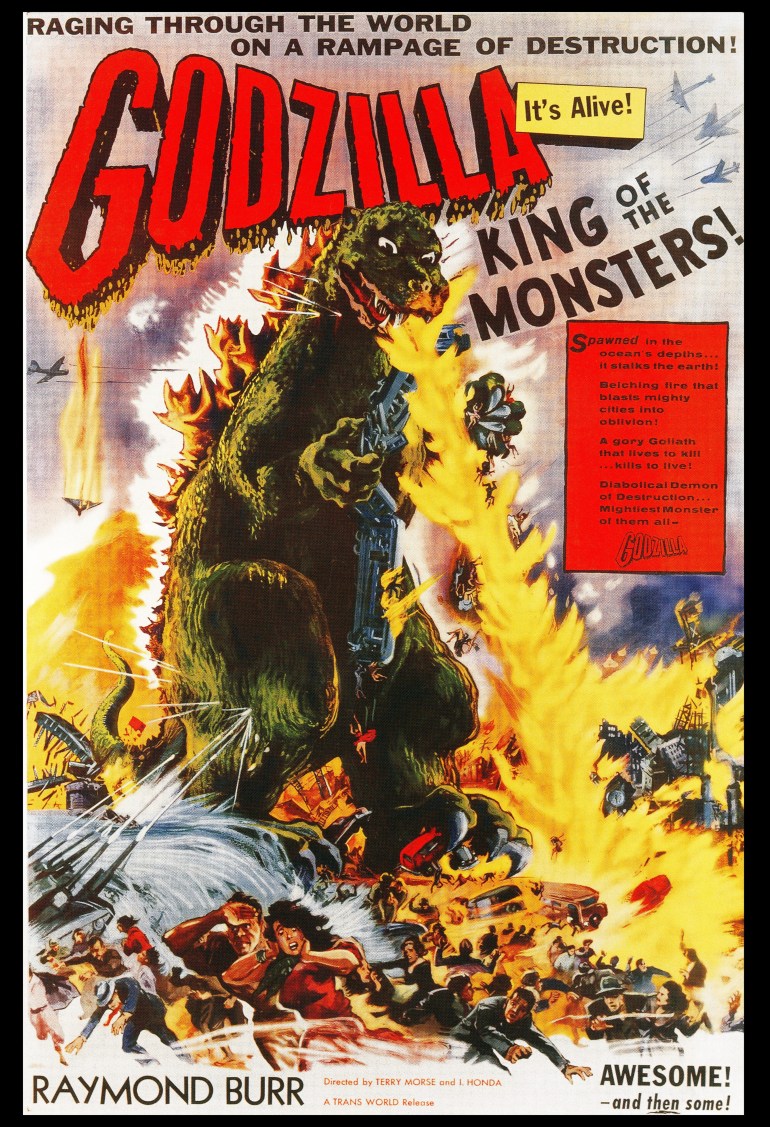
Yesterday’s Godzilla vs today’s Godzilla
The first Godzilla in 1954 laid waste to cities as the government and military tried to stop it. In the follow-up to Gojira’s success, 1955’s Godzilla Raids Again, Toho Studios would introduce a new monster for Godzilla to fight, an “ankylosaurus kaiju” named Anguirus.
This would serve as the inspiration for later films in which Godzilla would fight a different kaiju – sometimes several of them at the same time. During the so-called Showa era of 1954 to 1975, a new cadre of monsters, from Mothra to Ghidora, would be introduced. Even robot versions of Godzilla appeared, such as Mechagodzilla in 1973.
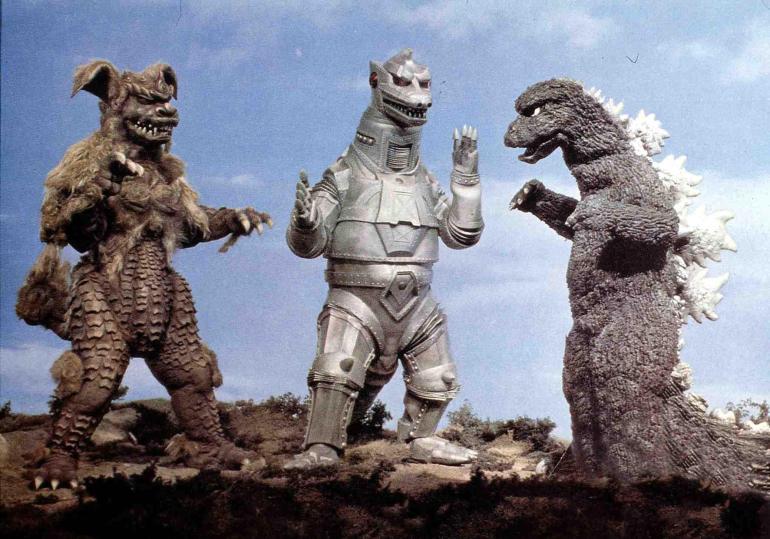
Toho Studios rebooted the series in 1984 with The Return of Godzilla, the first of the Heisei series, which ran from 1984 to 1995. The first film returned to the original 1954 version with Godzilla as a force of nature destroying cities and wreaking havoc and terror on humanity.
Later reboots would include the Millennium era movies (1999-2004) and the current Reiwa era, which includes the Toho Studios release of Godzilla Minus One in November last year. That film received multiple awards, including an Oscar for best visual effects, Japan Academy Film Prizes and Asian Film Awards.
The method of filming Godzilla movies using an actor in a monster suit in a miniature setting was employed for many years.
In 1998, German film director and screenwriter Roland Emmerich was in charge of creating an American version of the franchise, resulting in a Godzilla created using CGI, or computer-generated imagery, and other digital special effects.
In 2014, director Gareth Edwards took Godzilla in a new direction in his film starring Ken Watanabe. At 110 metres (350ft) tall with a tail span of 150 metres (500ft), this was a special effects version that was more than double the size of the 1954 Godzilla.
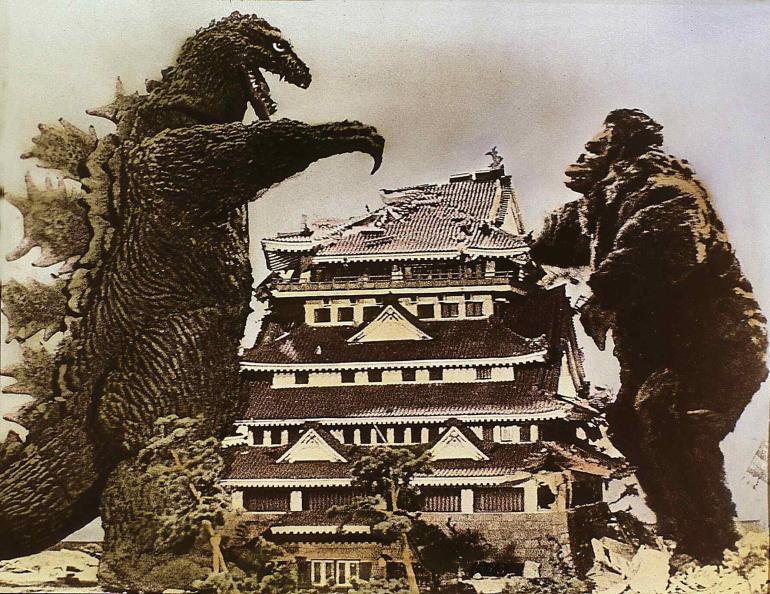
Why is Godzilla so popular?
Godzilla’s origin story in 1954 had a relatable context, being a metaphor for the tragedies of the atomic bombs dropped on Hiroshima and Nagasaki by the US.
But it was the “visceral displays of destruction, then unparalleled in American sci-fi pictures, where the monsters became characters with personalities and heroic bravura” that won over audiences in the decades following, according to Ryfle. “This is where Toho’s menagerie of kaiju first won the hearts and imaginations of film fans around the globe: where unforgettable battles between Godzilla and its foes flattened entire swathes of Japan,” he wrote in an article for the Criterion Collection, the film group, in 2019.
Godzilla has become such a cultural icon of Japan that in 2014, the central Shinjuku ward of Tokyo named Godzilla as its tourism ambassador.
During the unveiling ceremony at the Tokyo headquarters of Toho Studios, which features a giant Godzilla sculpture, Shinjuki Mayor Kenichi Yoshizumi stated: “Godzilla is a character that is the pride of Japan.”
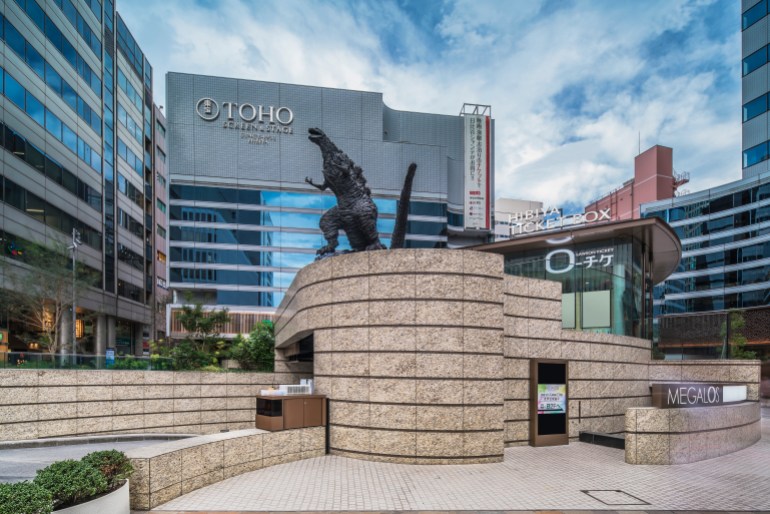
Godzilla has been a creature of reinvention over the years – and not just Godzilla, the character. Godzilla appears in a multitude of media, including comic books, films, TV series and animation. In 2017, Netflix released an animated film called Godzilla: Planet of the Monsters, and in 2021, the Japanese animated series Godzilla Singular Point was released.
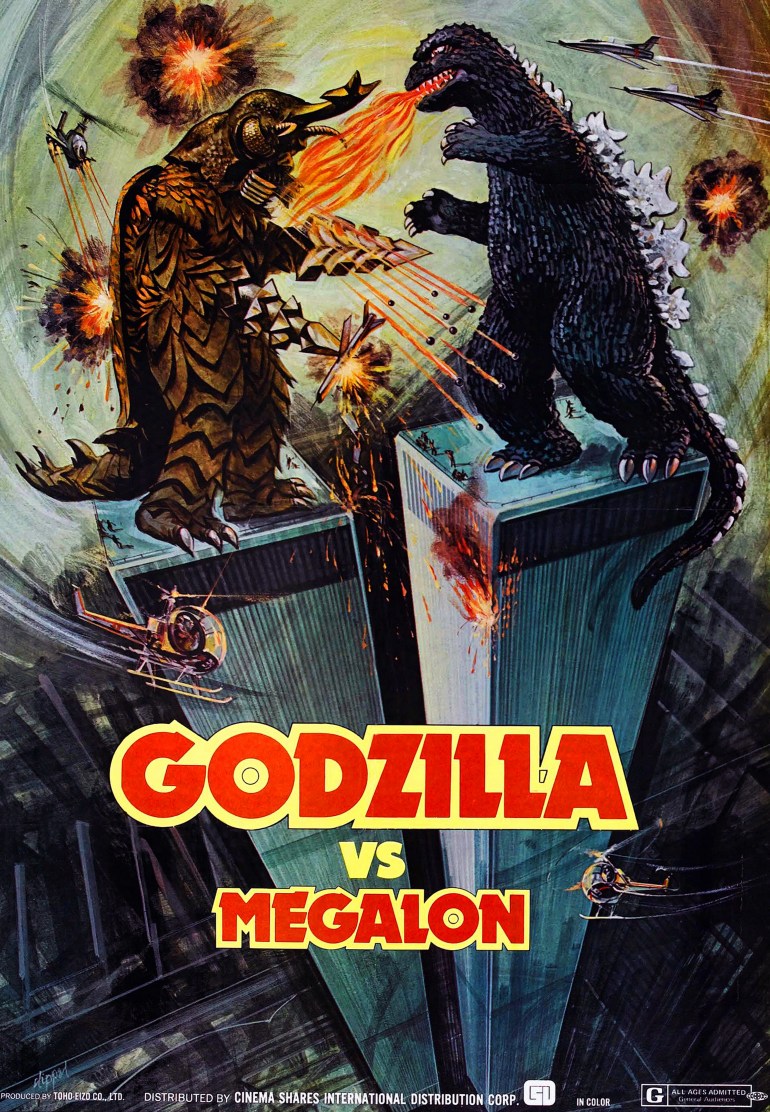
Other characters from the Godzilla movies have become popular as well. Classic characters from the Showa era have been reintroduced and reinvented with new storylines. They have included monsters from Mothra to King Ghidorah as well as newer characters such as Skar King, a gigantic primate-based creature that is featured in Godzilla x Kong.
This MonsterVerse is trying to replicate the same formula as the Marvel Cinematic Universe and its superhero movies with storylines that tie together multiple characters and reimagine original stories.
Obninsk Nuclear Power Plant
John morrissey march 15, 2015, submitted as coursework for ph241 , stanford university, winter 2015.
Obninsk Nuclear Power Plant was commissioned by the Soviet Union on June 27, 1954 and operated successfully for almost five decades, until it was closed on April 29, 2002. [1] Located a little more than a hundred kilometers southwest of Moscow, Obninsk was home to the Institute of Physics and Power Engineering, and as a result it is no surprise that the Soviets chose this spot to build the plant. [2] However what was so incredible about this plant was that Obninsk was the world's first nuclear power plant feed into an existing commercial grid. [3] Astonishingly, during the heat of the cold war this plant was not built with a military goal in mind, but rather the purpose of this plant was the generation of electricity and the facilitation of research.
Commercial Emphasis
With only one 5mWt reactor, this plant was not meant to solve the riddle of Soviet power, nor was it constructed to give the Soviets a leg up in the Cold War. [4] Instead the plant was built as an experiment for commercial electricity. Could a reactor be used to supply the commercial grid with energy? Obninsk proved that it could. The Reactor was a channel-type uranium- graphite design, a Soviet designed model that later gave birth to the powerful RBMK reactors. [5] The success of Obninsk paved the way for the building of many other commercial plants such as the Beloyarsk Nuclear Power Station in Russia and Sellafield, in England.
The Obninsk Nuclear Power Plant operated without a hitch for 48 years, an incredible feat when we consider the frequency of incidents at many modern-day plants around the world. Undoubtedly the relatively small size of the reactor contributed to this safety. However it is also important to note the mindset in which this facility was built. From the moment of its conception, Obninsk was referred to by the Soviets as Atom Mirnyi, or, Peaceful Atom. [6]
Founded over six decades ago, this plant was an incredible break through that showed the world there was a peaceful place for nuclear power in a future that, in the throws of the Cold War, seemed clouded in military dominance. From the moment of its construction, Obninsk was a quest to transfer the previously horrid and traumatic nature of nuclear energy into a positive resource for the growth and prosperity of humanity. Not only was this quest successful on this note, but the plant also lasted 50 years in operation without a single accident or spill, a model of stability that many of today's plants today could strive emulate.
© John Morrissey. The author grants permission to copy, distribute and display this work in unaltered form, with attribution to the author, for noncommercial purposes only. All other rights, including commercial rights, are reserved to the author.
[1] M. V. B. Rao and M. P. Rao, " Nuclear Energy Scenario of Asian Developing Countries ," Australian Solar Council , Visvesvaraya Institute of Technology, 28 Nov 08.
[2] V. K. Ivanov et al. , "Incidence among Nuclear Workers in Russia Based on Data from the Institute of Physics and Power Engineering: A Preliminary Analysis," Radiat. Res. 155 , 801 (2001).
[3] N. Armaroli, V. Balzani " Towards an electricity-powered world ," Energy Environ. Sci., 3193 , (July 2011).
[4] V. Brindha, " The First Nuclear Power Plant of Earth: June 27, 1954 ," Discovery 4 , No. 12,50 (June 2013).
[5] B. A. Semenov, " Nuclear Power in the Soviet Union ," IAEA Bull. 25 , No. 2, 47 (1983).
[6] S. D. Schmid, "Organizational Culture and Professional Identities in the Soviet Nuclear Power Industry," Osiris 23 , 82 (2008).

IMAGES
VIDEO
COMMENTS
Las Vegas is known as the city of lights and, at one time, that light was the glow of an atomic detonation in the Nevada desert. Starting in 1951, the US Army began testing nuclear ordnances just 65 miles from Sin City. At night, the glow of the bombs lit up the sky, and mushroom clouds could be spotted rising over the horizon during the day.
Atomic tourism or nuclear tourism is a recent form of tourism in which visitors learn about the Atomic Age by traveling to significant sites in atomic history such as nuclear test reactors, ... Nagasaki, last wartime use of an atomic bomb; United States Carson National Forest, Rio Arriba County, New Mexico - site of Project Gasbuggy;
May 8, 1953. With people clamoring to gaze at mushroom clouds, the Las Vegas tourism industry somewhat shifted, and establishments like the Horseshoe Club and the Desert Inn had unwittingly hit the atomic tourism jackpot. Their north-facing rooms gave fascinated guests an unobstructed view of the desert and the testing site.
Hiroshima Tourism Is More Popular Than Ever. More than seven decades ago the atomic bomb devastated an entire city—now millions of people visit. By Ari Beser. August 04, 2017. • 6 min read. In ...
Nevada National Security Site Tour. (702) 295-4117. Visit Website. Anyone visiting the Silver State, especially the Las Vegas area, should most definitely immerse themselves in Nevada's fascinating slice of atomic history. The National Atomic Testing Museum is located not far from the Strip, but you can really kick your history lesson up a ...
How 1950s Las Vegas Sold Atomic Bomb Tests as Tourism Between 1950 and 1960, the population of Las Vegas grew by 161%-partly due to the burgeoning casino industry. But another reason was a chance to glimpse actual nuclear tests in person. Atomic Tourism: Vegas Visitors Watch Nukes Explode
Atomic tourism is nearly as old as the nuclear age, and some of its favorite vintage haunts are still open. In the 1950s, Las Vegas casinos held "Miss Atomic Bomb" pageants and hosted ...
How 1950s Las Vegas Sold Atomic Bomb Tests as Tourism. Between 1950 and 1960, the population of Las Vegas grew by 161%--partly due to the burgeoning casino industry. But another reason was a ...
755 E. Flamingo Road, Las Vegas, NV 89119. (702) 409-7366. Hours & Admission. Visit Website. As you get to know the Silver State's spectacular story, make sure Nevada's atomic history is part of it. Situated minutes from the world-famous Las Vegas Strip, there's no better way to blast into the past than the National Atomic Testing Museum ...
Inside the New Wave of Atomic Tourism. ... they marvel at the lake-sized Sedan Crater created in 1962 by the below-ground explosion of a 104-kiloton hydrogen bomb. They see trenches where 1950s U ...
But in fact, tourists who went to Las Vegas to watch the nuclear tests helped fuel the growth of that city in the 1950s. In the 1950s, the United States carried out over 150 nuclear weapons tests above ground. Some of these tests - particularly the large-scale thermo-nuclear bomb tests like the 1954 Castle Bravo test, which had a 15-megaton ...
Atomic Tests Were a Tourist Draw in 1950s Las Vegas. Nevada's nuclear-bomb testing spawned a spectator culture tinged with both profound fear and Sin City delight. Today, downtown Las Vegas ...
3. The Atomic Era Triggered at Trinity Site. About 200 miles south of Los Alamos, in an area called Jornada del Muerto, or "journey of the dead," is Trinity Site. This really is a desert, and it ...
Atomic tourism, also known as nuclear tourism, refers to the practice of visiting sites and locations that are associated with significant nuclear events, such as nuclear weapons tests, nuclear accidents, or the history of atomic energy. ... Atomic bomb sites are locations that are closely associated with the detonation of atomic bombs. These ...
An atomic blast over Fremont Street, circa 1955. Las Vegas utilized its close proximity to the atomic testing grounds to promote itself as, 'Atomic City' a place where people could go and view atomic blasts. According to PBS An American Experience, 'On the eve of detonations, many Las Vegas businesses held 'Dawn Bomb Parties.'
website. address. 1-10 Otemachi, Naka-ku, Hiroshima City. Phone Number. 082-242-7831. business hours. All day. access. ・About 20 minutes by tram from Hiroshima Station, 1 minute on foot from Atomic Bomb Dome.・About 11 minutes by Hiroshima City Loop Bus from Hiroshima Station Shinkansen Exit, 1 minute walk from Atomic Bomb Dome-mae bus stop ...
This article shows that tourism development was a driving factor in the formation of Hiroshima memory culture from the start. By focusing on tourism, this article discusses a hitherto neglected aspect of public atomic bomb memory and raises criticism of area studies' ongoing preoccupation with the nation which risks overlooking local as well as structural factors.
By Ryan Lovelace - The Washington Times - Tuesday, April 9, 2024. Federal researchers working in a government lab famed for helping produce the atomic bomb during World War II are now focused on ...
Godzilla began life as a symbol of the horrific destruction caused by the atomic bombs dropped on Japan in 1945. ... the central Shinjuku ward of Tokyo named Godzilla as its tourism ambassador.
Obninsk Nuclear Power Plant was commissioned by the Soviet Union on June 27, 1954 and operated successfully for almost five decades, until it was closed on April 29, 2002. [1] Located a little more than a hundred kilometers southwest of Moscow, Obninsk was home to the Institute of Physics and Power Engineering, and as a result it is no surprise ...
Website. www .klimovsk .ru. Klimovsk (Russian: Климовск, IPA: [ˈklʲiməfsk]) is a microdistrict of Podolsk in Podolsk Urban Okrug, Moscow Oblast, Russia, located 55 kilometers (34 mi) south of Moscow and 8 kilometers (5.0 mi) south of Podolsk. [5] Population: 56,186 ( 2010 Census); [2] 55,644 ( 2002 Census); [6] 56,720 ( 1989 Census).
of Atomic Energy, USSR Council of Ministers, and USSR Member of die Agency's Board of Governors. Dr. Morokhov said mat radier dian talk briefly about many kinds of work in his country on die peaceful uses of atomic energy he had decided to choose one main aspect, nuclear power, since everyone had seen how much this had developed.
1st atomic power station opens (Obninsk, near Moscow, Russia) More Notable Events on June 27: 2008 Bill Gates resigns from Microsoft to focus on his charity work 1986 In referendum, Irish uphold ban on divorce 1985 Route 66, Chicago to Santa Monica, is decertified 1979 Muhammad Ali retires as boxing champ